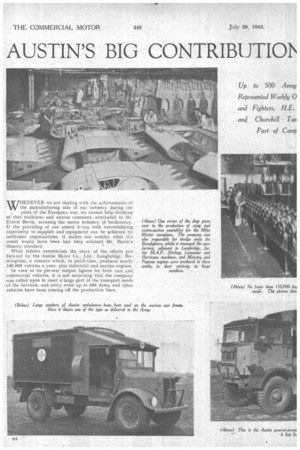AUSTIN'S BIG CONTRIBUTIOIN 10 THE FIGHTING SERVICES
Page 30

Page 31

Page 32

If you've noticed an error in this article please click here to report it so we can fix it.
WHENEVER we are dealing with the achievements of the manufacturing side of our industry during the
; years of the European war, we cannot help thinking of that malicious and untrue comment, attributed to Mr. Ernest Bevin, accusing the motoi industry of inefficiency. If the providing of our armed fcrces with overwhelming superiority in supplies and equipment can he achieved by inefficient organizations, it makes one wonder what the result would have been had they attained Mr. Bevin's illusory standard.
What follows summarizes the story of the efforts put forward by the Austin Motor Co., Ltd., Longbridge, Birmingham, a concern which, in peai!e-time, produces nearly 100,000 vehicles a year, plus industrial and marine engines.
In view of its pm-war output figures for both cars and commercial vehicles, it is not surprising that the company was called upon to meet a large part of the transport needs of the Services, and every week up to 500 Army and other vehicles have been coming off the productionlines.
These machines have ranged' from 8 h.p. utility cars to 3-ton lorries, including four-wheelers and six-wheelers with four-wheel drive, Army breakdown and fire-fighting vehicles, ambulances, R.A.F. tenders and troop carriers, signals and woikshop-units, gun portee trucks for 6-poumIPr anti-Tank guns, and gun tractors. By the end of the European war the total of such vehicles produced was over 115,000, no small achievement in itself for a single organization. , Vehicle production, however, was only one phase of the concern's activities, for it made extremely valuable contributions to the building up of the R.A.F. and providing the Royal Navy with much, vital equipment.
So far as the R.A.F. is concerned, the omponents ranged from balloon-cable cutters and small but high-precision jobs., such as hydraulic motors for gun turrets, to wing aild centre-section assemblies for Beaufighter and Miles Master aeroplanes, and Horsa glider, fuselages.
Oil and fuel tanks for four-engined bombers to the.
number of 15,000, and numerous small assemblies ranging from landing gears to components for Rolls-Royce engines and Rotol airscrews, represented other iterns. In the makingof the tanks 2,250,000 sq. ft. of_light-alloy metal was used.
Particularly extensive has been the output, of exhaust rings for Bristol aero-engines, of which over 122,000 have beeh produced at a special factory devoted to the work. A similar number of tails teL 250-1b., 1,000-1b,, and.4,000-ib. bombs, and some 300,000 Vickers and Hispano machine-gun magazines formed further contributions.
All the foregoing acre production is additional. to the stream of Stirling and Lancaster bombers, Hurricane lighters and Mercury and Pegasus engines which have -flowed from the aero factory adjacent to Lorigbridge, which has been managed by the Austin concern throughout the war for tee Ministry of Aircraft Production. .
Armour-piercing ammunition has been produced in great quantity at Longhridge, the total rounds for 2-, 6-, and 17-pounder guns being 1,350,000. Allied to this particular job was the 114 less tremendous .effort of turning out over 3,360,000 ammunition boxes, which weighed, in all, over 41,675 tons and repreSented 14,000 railway truck loads.
Magazines for machine-guns and tommy-guns comprised annther Austin contribution to Army needs; with Bran, Sten, and other magazines, the number of units produced was over 1,000,000.
Formerly, used to produce body panels for private cars, the Austin presses shaped more than 500,000 service helmets. Another job entailing the use of pressings was the making of 600,000 jerricans; these were actually assembled in a special factory which was taken over in South Wales.
Referred to by the Austin company as a formidable sideline was the not insignificant item of 110,000 bogie suspensio-is and a large number of driving-gear units for Churchill Tanks. These formed a contribution of the Austin engine machine shops.
Turning now to equipment for thd Royal Navy, the •droduction of mine hemisphere pressings, mine mechanism plates, and depth-charge pistols, amongst other auxiliaries, reached an aggregate of 410,000 assemblies, and the number
of Austin marine engines produced for ships' lifeboats for the Royal Navy and the Merchant, Navy was over 3,500..
Of particular assistance to the war at sea has been the production of over. 110,000 magazines'for the Ocrlikon gun) which, as may or may not he knoWn, served our sailors so well in beating oft enemy air attacks. No inconsiderable effort was that put forth by the Austin organization in supplying essential equipment for the war on the home front. -For instance, over 5,000 2-tormers were supplied for service in the N.F.S., and out of the total of 20,000 industrial .engines produced, over 10,000 have served to power fire pumps. Steel helmets, ofAustin make, for fire-watchers reached the 2,000,000 mark., So much, then, for the major production effort, hut what of the development work, in production methods, and, in many instances, in the actual design of the product, upon which these output figures so largely depended?
To take as examples,. Austin engineer§ developed new
methods of producing gun stampings for more rapid machining; the Oerlikon magazine design was modified to ensure greater dependability; the pioneer work in connection with the waterproofing of motor vehicles and engin2,s was largely performed at Longbriclge.
The Austin airborne lifeboat formed an outstanding instance of co-operation between the factory front and ,the fighting fronts in the development of new war equipment. Although the war in Europe is over, 'there is still the Pacific to engage attention,. and much of the Austin production will go on until this, too, is brought to a victorious conclusion.




























































